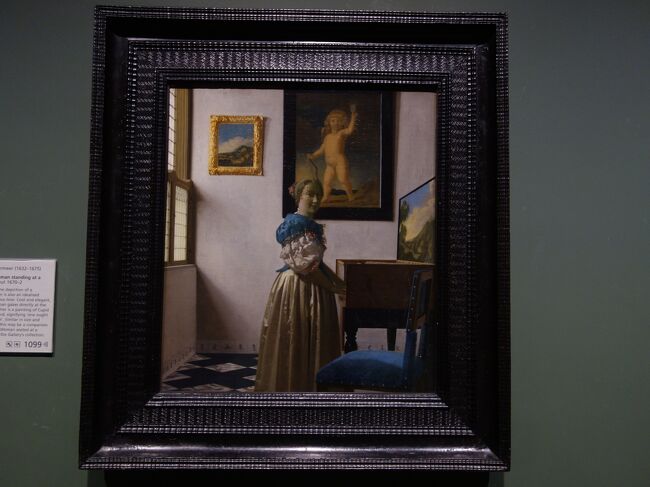
2020/01/29 - 2020/01/29
1115位(同エリア10339件中)
![]()
nomonomoさん
- nomonomoさんTOP
- 旅行記5305冊
- クチコミ9084件
- Q&A回答332件
- 6,549,966アクセス
- フォロワー104人
この旅行記のスケジュール
2020/01/29
この旅行記スケジュールを元に
ロンドン観光の初日。きっちり10時にナショナル・ギャラリーに行きました。ずっと見てまわって,あれっ,レオナルド・ダ・ヴィンチがあったはずだが。。。どの部屋に展示しているのかな。。。みつからないなぁ。。。。
係員に聞きました。「修復中で,2月1日土曜日になったら展示します。」そんなことがあるのです。
- 旅行の満足度
- 4.0
- 観光
- 4.0
- 交通手段
- 鉄道 徒歩
- 旅行の手配内容
- 個別手配
-
半年振りのNational Gallery の見学です。いろいろと回りましょう。
入場無料。来るっきゃない。毎日来てもいいくらい。 by nomonomoさんナショナルギャラリー 博物館・美術館・ギャラリー
-
Jan van Eyck
-
Jan van Eyck (active 1422: died 1441)
The Arnolfini Portrait, 1434
This portrait probably shows Giovanni
Armolfini, a wealthy Italian merchant
sesident i Bruges, and his wife. The
couple is shown in a richy furnished
living room; beds were a common feature
of such rooms. The mirror on the back
wall reflects two figures in a doorway.
Arnolfini's hand is raised, perhaps to
greet them. The painting is signed on
the wall above the mirror, 'Jan van
Eyck was here'.
Oil on oak
MG 186. Bought, 1842
429 -
-
Fra Filippo Lippi
(born about 1406; died 1469)
The Annunciation, about 1450-3
The Angel Gabriel announces the future
birth of Christ. The hand of God sends a
dove, a symbol of the Holy Spirit, in a
spiral towards Mary's womb. Gold rays
emanate from a hole in her dress.
Various symbols, such as lilies and the
walled garden, allude to her virginity.
Like its companion panel, the Seven
Saints, displayed nearby, this came from
Palazzo Medici in Florence and was
probably commissioned by the Medici
family. On the parapet is the Medici
device of three feathers within a ring.
Egg tempera on wood -
Fra Filippo Lippi
-
Fra Filippo Lippi
-
Sandro Botticelli (about 1445-1510)
Venus and Mars, about 1485
This panel was probably a spalliera
painting, one which was associated with
woodwork or furniture in a Florentine
palace bedchamber. Mars, the god of
war, is vanquished by Venus, goddess of
love and beauty. The shell the satyrs use
to blow into Mars' ear alludes to Venus'
birth from the sea. The wasps (vespe in
Italian) perhaps refer to the Vespucci
family for whom Botticelli worked.
Tempera and oil on poplar
NG915. Bought, 1874
183 -
Sandro Botticelli
-
Sandro Botticelli
-
Sandro Botticelli (about 1445-1510)
The Adoration of the Kings,
about 1470-5
Tondi (circular paintings) of this subject
were popular in the palaces of wealthy
Florentines. Botticelli has exploited the
format by placing the Virgin and Child
at the heart of the composition. Several
figures among the kings' courtly retinue
are portraits. The shepherds can be seen
in the distance. The ruined classical
temple represents the old pagan order.
Tempera on poplar
NG1033. Bought, 1878
184 -
Sandro Botticelli
-
Lorenzo di Credi
(about 1458-1537)
The Virgin and Child, 1480-1500
The archangel Raphael appears in the
distance with Tobias. Raphael was
venerated as a saint and may have
been added to what was a popular
composition at the request of the
patron. Credi was much influenced by
Leonardo da Vinci who had been with
him in the workshop of Verrocchio.
Oil and tempera on wood
NG593. Bought, 1857
646 -
Lorenzo di Credi
-
Raphael (1483-1520)
The Mond Crucifixion, about 1502-3
The lithe body of Christ is suspended on
a tall, slender cross in a misty dawn
landscape. The Sun and Moon on either
side symbolise the eclipse that occurred
at his death. Angels catch his blood in
chalices, similar to those used for the
wine of the Mass. The letters I.N.R.I.
stand for the Latin lesus Nazarenus Rex
ludaeorum (Jesus of
Nazareth, King of the Jews).
The Virgin and John the Evangelist
catch our eye, wringing their hands in
discrete sorrow. Kneeling are Mary
Magdalene and Saint Jerome, the sixth-
century theologian who translated the
Bible into Latin, and the sole character
depicted who was not at the Crucifixion.
This was the altarpiece for a burial
chapel dedicated to Jerome in San
Domenico, Citta di Castello.
Oil on poplar
NG3943. Mond Bequest, 1924
878 -
Raphael
-
Raphael
-
Raphael
-
Raphael (Raffaello Santi)
(1483-1520)
The Procession to Calvary,
about 1504-5
Christ carries the cross on his way to
Golgotha. Simon of Cyrene helps him.
Behind, the fainting Virgin is supported
by three holy women, while Saint John
the Evangelist, beside her, wrings his
hands. This painting was the central
panel of the predella (the scenes below
the main tier of an altarpiece) made for
the church of Sant'Antonio in Perugia.
Oil on wood
NG2919. Bought, 1913
877 -
Raphael
-
Raphael
-
Raphael
-
Raphael
-
Raphael (1483-1520)
The Ansidei Madonna, 1505
Raphael painted this altarpiece for the
chapel of the Ansidei family in the
church of San Fiorenzo in Perugia.
Responding to the challenge of its
restricted setting, Raphael was inspired
to produce one of the most imposing
and resolved altarpieces of his early
career.
The Virgin is flanked by Nicholas of Bari
and John the Baptist, name saints of the
patron and his son. The Baptist gazes up
at his slender crystal cross and points
towards Christ, foreseeing his Passion.
The altarpiece's division into harmonious
thirds is the result of careful geometrical
planning. Surprisingly, however, the
lofty vaulted architecture was an
afterthought, added when the painting
was well advanced. The brilliance of
Raphael's solution was to create the
illusion of a chapel-like space where
none may have existed.
Oil on poplar
NG1171. Bought, 1885
876 -
Raphael
-
Raphael
-
Titian (Tiziano)
(active about 1506; died 1576)
The Death of Actaeon,
about 1559-75
As punishment for surprising the goddess
Diana bathing, the hunter Actaeon was
transformed into a stag and killed by his
own hounds. The picture belongs to a series
made for Philip II of Spain. It was revised
extensively by Titian and never reached the
king. The freely worked paint has prompted
debate as to whether the picture is finished.
Oil on canvas
NG6420. Bought with a special grant
and contributions from The Art Fund,
the Pilgrim Trust and through public
appeal, 1972
1062 -
Titian
-
Titian (Tiziano)
(active about 1506; died 1576)
The Virgin suckling the Infant
Christ, about 1565-75
Christ eagerly suckles his mother's
breast. The Virgin supports him with
both hands, and regards him with
melancholy. Both the blurred forms
and the way in which paint has
been applied roughly to the canvas
are typical of Titian's last works. This
picture may have been one of those
left in Titian's studio at his death.
Oil on canvas
NG3948. Mond Bequest, 1924
1058 -
Titian
-
Titian
-
Thomas Gainsborough
(1727-1788)
The Painter's Daughters with
a Cat, about 1760-1
The painting is unfinished and the
outlines of a cat are just visible in the
younger girl's lap; her sister Mary is
tweaking its tail. Mary is shown here
aged about nine or ten; Margaret is
eight or nine.
Oil on canvas
NG3812. Bought, 1923
463 -
Thomas Gainsborough
-
Joseph Mallord William Turner
(1775-1851)
Calais Pier; An English Packet
Arriving, 1803
An English packet or mail-boat, crowded
with travellers, narrowly avoids collision
with a French fishing boat as it attempts
to land. This picture is based on Turner's
experience of a stormy landing at XCalais
during his first trip i 1802.
Oil on canvas
NG472. Turner Bequest, 1856
1070 -
Joseph Mallord William Turner
-
Joseph Mallord William Turner
(1775-1851)
The Parting of Hero and Leander,
before 1837
The subject is taken from the Greek
myth Hero and Leander. Hero looks on
as her lover Leander begins his daily
swim across the Hellespont. Sea nymphs
who were thought to control the waves
are shown on the right. The brewing
storm foreshadows Leander's drowning.
Oil on canvas
NG521. Turner Bequest, 1856 -
Joseph Mallord William Turner
-
Joseph Mallord William Turner
-
Joseph Mallord William Turner
(1775-1851)
The Evening Star, about 1830
A boy walks along the seashore,
carrying a shrimping net over his
shoulder and accompanied by a small
white dog. The evening star appears
as a faint point in the sky, reflected
more brightly in the water. The
painting is unfinished and a boat has
been painted out at centre right.
Oil on canvas
NG1991. Turner Banquest, 1856
1179 -
Joseph Mallord William Turner
-
Joseph Mallord William Turner
(1775-1851)
Dutch Boats in a Gale
('The Bridgewater Sea Piece'), 1801
Dutch boats are shown on course for
collision in stormy weather. Dark clouds
contribute to the sense of danger. The
painting was commissioned by the 3rd
Duke of Bridgewater as a companion
piece to a 17th-century Dutch seascape
in his possession.
Oil on canvas
L297. On loan from The Capricorn
Foundation, London
1069 -
Joseph Mallord William Turner
-
Paul Cezanne (1839-1906)
Bathers (Les Grandes Baigneuses),
about 1894-1905
Eleven female figures repose in an
imaginary landscape bordered by trees.
The forms of the landscape mirror the
women's sculptured bodies. Cezanne
outlines the figures and the main
features of the background in blue,
heightening the serene atmosphere and
suggesting unity between people and
nature.
Oil on canvas
NG6359. Purchased with a special
grant and the aid of the Max Rayne
Foundation, 1964
253 -
Paul Cezanne
-
Pierre-Auguste Renoir (1841-1919)
The Umbrellas, about 1881-6
This bustling Paris street in the rain is
typical of the scenes of everyday modern
life beloved by Renoir and the
Impressionists. A milliner's assistant
holding a bandbox looks out at the
viewer, as does a little girl, while a canopy
of umbrellas unfurl behind them. Renoir
began the painting using a soft, feathery
style, but later reworked the left side
using harder contours and muted colours.
Oil on canvas
NG3268. Sir Hugh Lane Bequest, 1917
909 -
Pierre-Auguste Renoir
-
Pierre-Auguste Renoir (1841-1919)
Misia Sert, 1904
Maria Godebska (1872-1950), known as
Misia, was a well-known figure among
avant-garde artists in Paris at the turn
of the last century. Many of them
painted her portrait. Misia married
three times. Her third husband was the
Spanish painter Jose Maria Sert, whom
she married in 1920.
Oil on canvas
NG6306. Bought, 1960 -
Pierre-Auguste Renoir
-
Paul Cezanne
-
Pablo Picasso (1881-1973)
Motherhood (La Maternite), 1901
Picasso looks afresh at the subject of the
Madonna and Child, dressing the
mother in traditional blue. Her gaze is
melancholic and her elongated arms
cocoon the child in a tender embrace.
The stylized landscape, a balanced
patchwork of reds and greens, is
invigorated by loose expressive
brushstrokes at the top and bottom left.
Oil on fibre board
L1232. On loan from a private collection -
「聖母子」との解釈!
-
Vincent Van Gogh (1853-1890)
Farms near Auvers, 1890
Van Gogh loved the 'mossy thatched
roofs' which he saw near his last
home at Auvers, close to Paris. A
row of dilapidated farm buildings
dominates this picture, made a month
before the artist's death. Their shapes
are mimicked by the fields and hills
behind. The hasty brushwork and
blank sky suggest that the painting
is unfinished.
Oil on canvas
L711. On loan from Tate.
Bequeathed by C. Frank Stoop 1933
1266 -
死の一ヶ月前の作品だそうです。
-
Vincent van Gogh (1853-1890)
A Wheatfield, with Cypresses,
1889
Cypress trees reminded Van Gogh of
'Egyptian obelisks'. These dark trees
were in a wheatfield close to the
St-Remy mental asylum near Arles
where the artist spent a year as a
patient. They stand straight and tall
in the middle of the wheat, and make
a strong and deliberate contrast with
the receding horizontal bands of the
yellow field, blue hills and sky.
Oil on canvas
NG3861. Bought, Courtauld Fund, 1923
496 -
Vincent van Gogh
-
Vincent van Gogh (1853-1890)
Sunflowers, 1888
Van Gogh associated the colour
yellow with hope and friendship. He
suggested that his four Sunflowers
canvases, painted to decorate his
house in Arles, express an 'idea
symbolising gratitude'. He seems to
have been especially pleased with this
picture, which he hung in the guest
bedroom in anticipation of the arrival
of his friend, the artist Paul Gauguin.
Oil on canvas
NG3863. Bought,
Courtauld Fund, 1924
497 -
Vincent van Gogh
-
Vincent van Gogh (1853-1890)
Van Gogh's Chair, 1888
A simple yellow chair stands on an
earthenware floor, contrasting with the
blue door and wall. The artist's tobacco
and pipe have been placed haphazardly
on the chair. Behind, some sprouting
onions peek out of a box. Van Gogh
meant this simplc composition of
everyday objects to represent his
direct and plain-speaking character.
Oil on canvas
NG3862. Bought, Courtauld Fund,
1924
1181 -
Vincent van Gogh
-
Vincent van Gogh (1853-1890)
Head of a Peasant Woman,
about 1884
In winter 1884-5 Van Gogh was living
at Nuenen in the Netherlands where
his father was a minister. There he
painted some 40 heads of local
peasants, including this work. Dark,
coarse and unidealised, they
constitute his first major achievement
as an artist.
Oil on canvas
NG6648. Accepted under the Cultural Gifts Scheme by HM
Government and allocated to The National Gallery, 2013 -
Vincent van Gogh
-
Vincent van Gogh
-
Vincent van Gogh
-
Edouard Manet (1832-1883)
The Execution of Maximilian,
about 1867-8
Archduke Ferdinand Maximilian had
been installed as puppet emperor of
Mexico by Napoleon III but was executed
by Mexican Republicans in 1867. Only
Maximilian's hand is visible here, clasped
by one of his generals. The painting was
cut up after Manet's death; Edgar Degas
later reassembled the fragments.
Oil on canvas
NG3294. Bought, 1918
661 -
Edouard Manet
-
Edouard Manet (1832-1883)
Eva Gonzales, 1870
The painter Eva Gonzales (1849-1883)
entered Manet's studio in February 1869,
first as his model and then as his student.
Although Manet portrays her applying
the finishing touches to a flower painting,
she wears a white satin dress unsuitable
for painting with oils and the canvas is
already framed. The present whereabouts
of the still life is not known.
Oil on canvas
NG3259, Sir Hugh Lane Bequest, 1917
659 -
Edouard Manet
-
Paul Delaroche (1797-1856)
The Execution of Lady Jane Grey,
1833
Lady Jane Grey reigned as queen for
nine days in 1553 until deposed by
supporters of the Catholic Queen Mary.
She was beheaded at the Tower of
London. The French painter Delaroche
was famous for his scenes of British
royalty, especially those who were
doomed or dying.
Oil on canvas
NG1909. Bequeathed by the Second
Lord Cheylesmore, 1902
363 -
Paul Delaroche
-
Johannes Vermeer (1632-1675)
A Young Woman standing at a
Virginal, about 1670-2
Vermeer's serene depiction of a
keyboard player is also an idealised
image of virtuous love. Cool and elegant,
the young woman gazes directly at the
viewer. Behind her is a painting of Cupid
holding up a card, signifying 'one ought
to love only one'. Similar in size and
subject matter, this may be a companion
piece to Young Woman seated at a
Virginal, also in the Gallery's collection.
Oil on canvas
NG1383. Bought, 1892
1099 -
Johannes Vermeer
-
Johannes Vermeer
-
Johannes Vermeer
-
Johannes Vermeer
-
Rembrandt (1606-1669)
Belshazzar's Feast, about 1636-8
At a lavish feast, the Babylonian king
Belshazzar served wine in precious
vessels that one of his predecessors had
looted from the temple at Jerusalem
(Daniel 5: 1-5; 25-28). A divine hand
appeared and wrote in Hebrew: 'God
hath numbered thy kingdom, and
finished it. Thou art weighed in the
balances, and art found wanting.'
Belshazzar was killed that same night.
Oil on canvas
NG6350. Bought with a contribution
from The Art Fund, 1964
900 -
Rembrandt
-
Rembrandt
-
Rembrandt (1606-1669)
Self portrait at the Age of 63, 1669
Rembrandt appears quite frail in this
moving likeness painted in the final year
of his life; his hands are limp, his skin is
pasty, and even his characteristic wiry
hair seems subdued. Still, the portrait is
painted with great sensitivity. Paint is
thickly appplied in the highlighted areas
of the face, while darker areas are more
thinly painted,
Oil on canvas
NG221. Bought 1851
886 -
Rembrandt
-
Rembrandt
-
Rembrandt
-
Rembrandt (1606-1669)
Portrait of Frederick Rihel on
Horseback, about 1663
This is the only equestrian portrait
Rembrandt ever painted. Frederick Rihel
was a wealthy Amsterdam businessman.
An avid and accomplished horseman, he
may have encouraged Rembrandt to
tackle this unusual format. The portrait
commemorates the part Rihel played in
welcoming Prince William of Orange
into Amsterdam in 1660.
Oil on canvas
NG6300. Bought with a special grant
and contributions from The Art Fund
and The Pilgrim Trust, 1959
899 -
Rembrandt
-
Rembrandt (1606-1669)
Saskia van Uylenburgh in Arcadian
Costume, 1635
Rembrandt made this portrait of his wife
in the year after their marriage. His
decision to portray her in the romantic
guise of a shepherdess, or Flora, the
Roman goddess of spring, reflects the
contemporary taste for rustic themes.
Saskia, the daughter of a wealthy mayor
from the northern Netherlands, died in
1642, aged just 30.
Oil on canvas
NG4930. Bought with contributions
from The Art Fund, 1938
896 -
Rembrandt
-
Peter Paul Rubens (1577-1640)
Samson and Delilah, about 1609-10
Rubens's interpretation of this Old
Testament story is tense and powerful.
Samson's Nazirite vows forbade the
cutting of hair, in return, God gave him
great strength. Delilah was bribed by
the Philistines to seduce Samson and cut
his hair as he slept, so that soldiers could
capture the weakened hero. Dramatic
lightinf reflects Rubens's awareness of
the Italian painter, Caravaggio.
Oil on wood
NG6467. Bought, 1980
961 -
Peter Paul Rubens
-
Diego Velazquez (1599-1660)
Philip IV of Spain, about 1656
The King is shown at the age about
50 and this is probably the last portrait
that Verazquez made of Philip IV,
whom he had served since 1623. Philip
is known to have felt incomfortable at
seeing himself ageing in Velazquez's
late portraits. He wears the badge of
the Order of the Golden Fleece on a
chain.
Oil on canvas
NG745 Bought, 1865
1088 -
Diego Velazquez
-
Diego Velazquez (1599-1660)
The Toilet of Venus ('The Rokeby
Venus'), 1647-51
Venus reclines on a bed before the
mirror held up by a winged Cupid. The
reflection shows her face, suggesting
that she is observing the viewer rather
than herself. The female nude is very
rare in Spanish painting at this date.
During the 19th century the painting
was at Rokeby Park, hence its subtitle.
Oil on canvas
NG2057. Presented by The Art Fund,
1906
1092 -
Diego Velazquez
-
Diego Velazquez (1599-1660)
Philip IV of Spain in Brown and
Silver, about 1631-2
King Philip (reigned 1621-1665) wears
a suit of unusual splendour, and the
painting may be intended to record the
particular occasion on which he wore
it. He wears the badge of the Order
of the Golden Fleece on a chain. The
portrait, which is superbly preserved,
is one of the few signed by the painter.
Oil on canvas
NG1129. Bought, 1882
1089 -
Diego Velazquez
-
Michelangelo Merisi da
Caravaggio (1571-1610)
Salome receives th Head of John
the Baptist, about 1609-10
When Salome was granted a wish by
King Herod, she asked for the head of
John the Baptist (Mark 6). Although
often shown triumphant, here Salome
turns away from the grisly sight. This
work was painted after Caravaggio was
forced to flee Rome for killing a man.
Oil on canvas
NG6189. Bought, 1976
232 -
Caravaggio
-
Michelangelo Merisi da Caravaggio
(1571-1610)
The Supper at Emmaus, 1601
After his Resurrection, Christ walked
to Emmaus with two disciples. The men
only recognised him when they dined
together and Christ blessed the bread
(Luke 24), as he had done at the Last
Supper. The inn-keeper stands behind
Christ. One disciple starts out of his
chair while the other throws his arms
wide in astonishment. This disciple
wears a shell, the emblem of a pilgrim.
Oil and tempera on canvas
NG172. Presented by Lord Vernon, 1839
231 -
Caravaggio
-
Caravaggio
-
Michelangelo Merisi da
Caravaggio (1571-1610)
Boy bitten by a Lizard,
about 1594-5
The subject may be an allegory of the
possible pain of love, or simply a study in
expression. The painting is one of
several related works by Caravaggio
made expressly for the market, with a
particular group of wealthy patrons in
mind.
Oil on canvas
NG6504. Bought with the aid of a
contribution from the J. Paul Getty Jr
Endowment Fund, 1986
233 -
Caravaggio
-
Caravaggio
-
Caravaggio
-
こんな掲示がありました。
Leonardo:
Experience a Masterpiece
9 November 2019 -
12 January 2020
Ground Floor Galleries * £
1月12日までの特別展に出ていて,いまはお休み中なのでしょうか。 -
お疲れ様でした。今日はカフェには寄りません。
ギャラリーの出口にあります。外から(東側)も入れます。 by nomonomoさんナショナル カフェ (ナショナルギャラリー内) カフェ
-
ショップでお買物をして,出ましょう。
入場無料。来るっきゃない。毎日来てもいいくらい。 by nomonomoさんナショナルギャラリー 博物館・美術館・ギャラリー
-
見たかったLeonardoは,
The Virgin and Child with Saint Anne and Saint John the Baptist
(The Burlington House Cartoon)
と -
The Virgin of the Rocks
です。
ふたつともおいていないとは,驚き以外の何物でもありません。
利用規約に違反している投稿は、報告する事ができます。
旅行記グループ
フェルメール巡礼
-
前の旅行記

NYCを歩く。(5.7) Frick Collection でフェルメールを見る。ここにも3枚あります。
2019/08/21~
ニューヨーク
-
次の旅行記
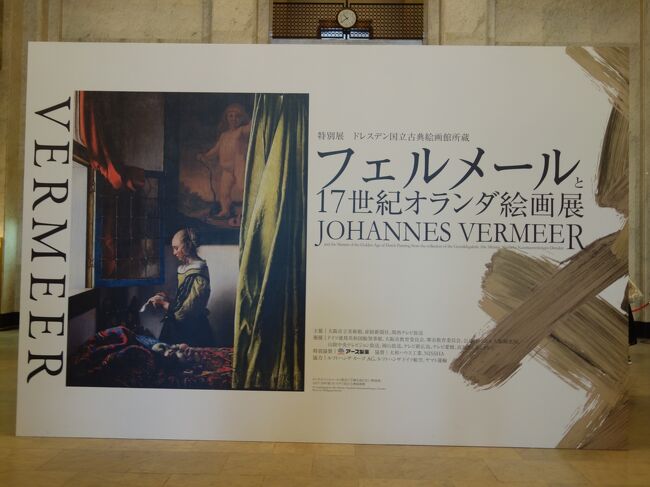
フェルメールを見に大阪市立美術館へ。フェルメール巡礼の大成です。
2022/07/20~
ミナミ(難波・天王寺)
-

Vermeer を見にKenwood House をたずねました
2009/06/07~
ロンドン
-
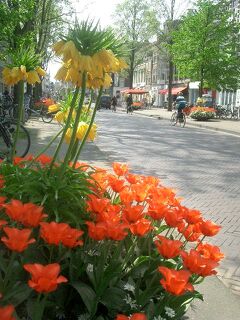
ハーグの駅からマウリッツハイム美術館まで街歩き
2011/04/21~
ハーグ (デン・ハーグ)
-

フェルメールの風景をデルフトでさがす。スヒー川越しに町を眺める
2011/04/22~
デルフト
-

アムステルダムで最初に行くところは、もちろん、国立美術館。
2011/04/24~
アムステルダム
-
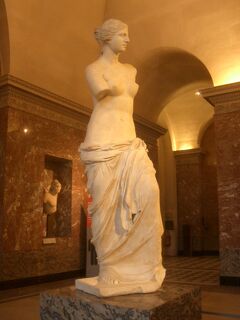
やっぱりルーブル。パリ7日目にしてモナリザに会いました。
2013/01/27~
パリ
-
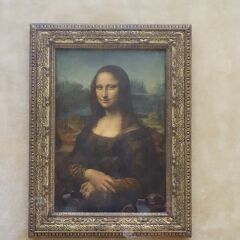
今日は第一日曜日。美術館ただの日。さあ,美術館を回りましょう。まずはルーブルから。
2014/02/02~
パリ
-

フェルメール展を大阪市美術館で見て来ました。6点ありました。よかった。
2019/04/17~
ミナミ(難波・天王寺)
-

ロンドンを歩く。(1.5) バッキンガム宮殿の the State Rooms でフェルメールをみる。
2019/07/24~
ロンドン
-
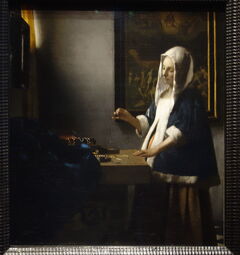
Washington D.C. を歩く。(2) 最大の目的はナショナルギャラリーのフェルメールです。レオナル...
2019/08/19~
ワシントンD.C.
-
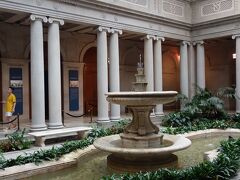
NYCを歩く。(5.7) Frick Collection でフェルメールを見る。ここにも3枚あります。
2019/08/21~
ニューヨーク
-

London(1.2) National Gallery に Leonardo がない!ウッソ!まさか!そん...
2020/01/29~
ロンドン
-

フェルメールを見に大阪市立美術館へ。フェルメール巡礼の大成です。
2022/07/20~
ミナミ(難波・天王寺)
旅行記グループをもっと見る
コメントを投稿する前に
十分に確認の上、ご投稿ください。 コメントの内容は攻撃的ではなく、相手の気持ちに寄り添ったものになっていますか?
サイト共通ガイドライン(利用上のお願い)報道機関・マスメディアの方へ 画像提供などに関するお問い合わせは、専用のお問い合わせフォームからお願いいたします。
この旅行で行ったスポット
この旅行で行ったグルメ・レストラン
ロンドン(イギリス) の旅行記
旅の計画・記録
マイルに交換できるフォートラベルポイントが貯まる
フォートラベルポイントって?

















































































































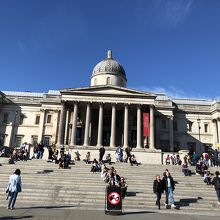












旅行記グループ フェルメール巡礼
0
107